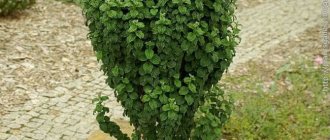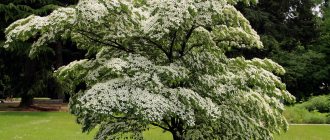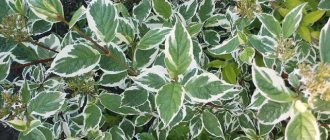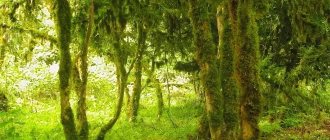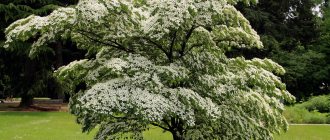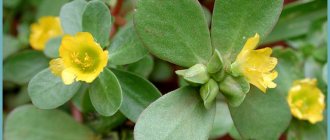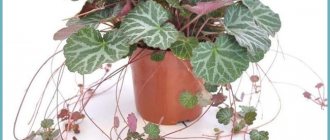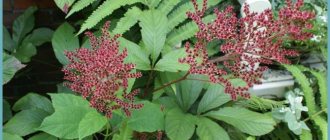Plants with decorative leaves decorate the garden no worse than beautifully flowering specimens. In addition, these crops are extremely unpretentious.
Decorative garden plants are good because they will take root both in a shady corner and in a sun-drenched rocky garden. By combining them, you can create a variety of flower arrangements. Such a flowerbed will never be boring, even despite the lack of colorful flowering.
Coleus
There are so many types of coleus in nature that choosing the most beautiful one can sometimes be difficult. Moreover, not all of these plants are distinguished by decorative foliage, some still bloom very nicely, and other species have edible roots and leaves.
Coleus is still better known as an incredibly beautiful ornamental foliage plant. The most popular types are Blume and Verschaffelta . If you want the coleus to show itself in all its glory, pick off the flowers. First of all, they are not very attractive. Secondly, flowering weakens plants and prevents them from growing colorful foliage.
Ground cover perennial plants for a rocky garden: photos and names
Some of the best ground cover plants are aubrieta, saxifrage, two-seed, dianthus and cat's foot.
Forms extensive carpet thickets. It blooms all spring with small bright flowers; their color varies among different species from pink to purple. It is unpretentious to soils, but prefers well-aerated, non-acidic loams. Sun-loving. Winter-hardy, but to preserve wintering shoots, cover with spruce branches. The best plants for creating flowering carpets in sunny rock gardens and for planting on retaining wall terraces.
Trim shoots with faded flowers - this causes better regrowth of new shoots, and sometimes secondary flowering.
Almost all natural species are suitable for rockeries, but hybrids are more often used. Grayish-blue Carnation (D. gratiano-politanus)
Dianthus plumata (D. plumaris) is a carpet species with narrow leaves. Varietal forms bloom in early summer.
As you can see in the photo, this ground cover plant has straight peduncles, from 3 to 30 cm, white or pink flowers:
Caladium
A plant that is also valued for the beauty and unusualness of its foliage and is often found in our gardens or on the windowsills of houses and apartments. But not everyone knows its name - caladium. It, like coleus, can also be very different.
Depending on the variety, the leaves of the plant are green, yellow, white, pink or purple. Moreover, specimens with monochromatic foliage are just as good as varieties with colored veins, spots, stripes or dots on the leaves. What kind of designs nature creates on caladium leaves! The only shade that is unusual for the culture is blue. But there are plant varieties with a bluish coating on the leaves - very beautiful.
During the winter, the caladium “falls asleep” - it sheds its leaves, so do not rush to throw away the plant, even if it seems to you that it has died.
Perennials with variegated leaves. Variegated perennials
Nature has arranged it so that most plants have green leaves, and flowers and fruits have the colors of the rainbow. However, there are many plants of variegated forms and varieties, and some of them even look better without flowers.
Therefore, we will focus only on variegated perennials that can decorate our flower beds. If desired, you can make a flower garden only from them. True, if they are not diluted with calm greenery, it will be colorful.
Liliaceae
.
They all love acidic forest soils and partial shade. With such plants, which not only bloom beautifully, but also have decorative foliage, you can enliven the shady corners of the garden. The Liliaceae family gave us hosts
(Hosta), or funkia. Today there are already more than 600 varieties of hosta, and every year more and more new, amazing and luxurious ones appear.
Kupena
- also a genus of the Liliaceae family.
At the lily of the valley in May
(Convallaria majalis) also has a variegated form, and not even just one.
Saxifraga
The extensive saxifrage family is rich in variegated leaves. Here the palm belongs, perhaps, to the heucheras
(Heuchega). Heucheras are winter-green plants; their leaves remain under the snow until spring, until new ones begin to grow. Heucheras are undemanding to soil, but in well-drained and fairly moist areas in light partial shade they grow very lush and spectacular. They are propagated vegetatively - by lateral rosette cuttings, which quickly take root in sufficiently moist soil.
Tiarki
(Tiarella), like heucheras, are winter-green plants that prefer moist, loose soil. This is an excellent ground cover crop for shady areas.
As a result of crossing tiara with heuchera, a hybrid was obtained - heucherella
(Heucherella). It combines the beauty of the inflorescences with the spectacular colors and shape of the leaves of its “parents”.
Another shade-tolerant ground cover plant native to America is Tolmiea Menzies
(Tolmiea menziesii). And although it is better known as an indoor plant, it also feels great in open ground. Tolmia leaves have an interesting feature - at the very base of the leaf blade small plants are formed that can take root and subsequently exist independently.
Well, and, finally, the saxifrages
. In gardens they are mainly an integral component of rockeries. Saxifragas are usually grown for their beautiful and abundant flowers, as well as the nice dense cushions that some species produce.
But perhaps the richest in variegated forms is the Lamiaceae family
. Among its representatives there are many ground cover plants, which are simply irreplaceable in mixed flower beds, rock gardens and shady areas.
First of all, it's a spotted damselfly
(Lamium maculatum), colloquially called dead nettle. The height of these “nettles,” depending on the variety, is from 15 to 30 cm. Growing quickly, they form elegant curtains that retain their beauty until the frost and disappear under the snow with leaves. Laminaria thrive in partial shade and are undemanding to soil. From time to time, the jackets need to be trimmed so that they do not lose their decorative appearance and grow more luxuriantly.
A close relative of the chrysalis is the yellow zelenchuk
(Galeobdolon luteum), often found wild in deciduous and mixed forests of the temperate zone. It grows very quickly, scattering long creeping shoots to the sides, resulting in a continuous carpet up to 20 cm high. Zelenchuk is used when you need to quickly “drape” bare areas even in complete shade. True, in partial shade and in the sun the bright color will appear better.
Budra ivy-shaped
- in the wild it is an ordinary modest plant of our mixed forests, but its variegated form is unusually decorative. It grows quickly, but not as much as the wild one, forming a low (5-8 cm), like a lace carpet of round leaves with a white edge. This is another beautiful and very unpretentious ground cover plant for shade and partial shade.
For the sunny slopes of the alpine hills, the Lamiaceae family “has” various types of thymes
, plants of steppe origin, as a rule, very fragrant, forming dense cushions or loose curtains of creeping shoots with small leaves.
Another species of the Lamiaceae family common in the middle zone is the creeping tenacious
(Ajuga reptans). The wild survivor looks more than modest, only in May-June, when the blue “candles” bloom, does it become elegant. The contrast and brightness of color is best seen in the sun, although the tenacious ones grow well in partial shade. The tenacious ones grow with the help of “whiskers”, each of which produces several rooted rosettes over the summer, while the mother one dies after flowering. They require almost no care (except for reasonable watering).
Suaveolens mint looks incredibly impressive in sunny areas.
(Mentha suaveolens) Variegata, whose delicate light green leaves are outlined by an uneven white border. Mint grows in lush, low clumps 35-45 cm high, but is quite aggressive, and therefore should be limited in the literal sense of the word.
There are also several bright oregano
- ordinary oregano. The plant loves sun and permeable soil.
One of the most fashionable plants now is physiostegia.
virginiana (Physostegia virginiana) The plant is remarkable in all respects - it is very unpretentious, frost-resistant, does not suffer from diseases and pests, and forms dense thickets on sufficiently fertilized wet sandy loam and loam. Physostegia grows well both in the sun and in partial shade, blooms for up to one and a half months, by the way, it is very popular in bouquets.
Everyone is probably familiar with the Byzantine chist
(Stachys byzantina). In order for the chickweed to grow better and not become a weed, the flower stems must be cut off immediately after flowering. This plant loves the sun and well-drained soil; it remains decorative until winter and goes under the snow with rosettes of leaves.
The Borage family is noted for its rather massive Brunnera
and comfrey. Variegated brunners love moisture and partial shade; during drought or too much sun, the white edges of the leaves can turn brown and dry out.
Comfrey
especially decorative in spring and autumn, when young rosettes grow. Loves moist soil.
But the most variegated ones in the Borage family are among the lungworts
. Lungworts are shade-tolerant and cold-resistant, requiring almost no care (except for watering in too dry times). These are wonderful ground cover plants for a shady garden.
Moths.
In the Moth family there is a charming
creeping clover
.
Bluebirds
represented by very popular plants.
This is blue cyanosis
.
There are several variegated phlox
. It grows with the help of creeping shoots, an excellent ground cover for rockeries in partial shade, prefers forest soils, and is unpretentious.
Phlox stoloniferous
(Ph. stolonifera) white-bordered - low ground cover for the edge of a shady garden, undemanding to soil, but does not tolerate lime.
Variegated Phlox subulate
(Ph. subulata) forms dense cushion-shaped thickets, prefers sun, well-drained soils, and requires watering in summer. This semi-evergreen plant requires pruning after flowering.
Flower growers know the Buttercup family from their variegated aquilegias.
They are all very unpretentious.
Variegated form of creeping buttercup
(Ranunculus repens) is a groundcover for sun and partial shade that very quickly forms a continuous carpet; its excessive aggressiveness can add to the nuisance.
Nornicaceae.
The Norichinaceae family contributes to the variegated collection with several varieties of speedwells
.
Veronica gentiana loves partial shade, prostrate - sun, dry sandy and calcareous soils. After flowering, it is useful to trim the jacket. Speedwells are an excellent ground cover for rockeries; they are decorative all summer long.
The Plantain family is represented by the greater plantain
(Plantago major) Atropurpurea, which reproduces by seeds. But care must be taken that it does not cross-pollinate with green individuals, otherwise the color of the seedlings will not be bright.
Family Umbrella
.
Astrantia Suningdale Varigated
with white-edged leaves and probably the familiar variegated warbler, which is not as aggressive as the natural species.
Poppy family
.
With yellow leaves and pink flowers, Dicentra Gold Heart
Family Rosaceae. Common meadowsweet
(Filipendula ulmaria) has two variegated forms - Variegata with a clear cream pattern in the center of the leaf and Aurea with yellow leaves. These plants grow well in partial shade in moist soils. Blunt burnet (Sanguisorba obtusa) Lemon Splash - with large, showy purple inflorescences and leaves, unevenly spotted with yellow specks. An excellent ground cover from this family is the Chilean strawberry Variegata, with white-edged leaves that grows quickly with the help of tendrils.
Family Primroses
.
It is represented by a few, but very valuable plants: this is the loosestrife
(Lusimachia nummularia) Aurea - a fast-growing, unpretentious low ground cover that will create a sunny spot in a shady garden and decorate the base of dwarf conifers.
Family Poaceae
and
Sedges
. Their “war color” is represented mainly by a contrasting border, a contrasting central vein, longitudinal and sometimes transverse stripes, yellow, glaucous, and blue leaves. Some grasses have the ends of the leaves or even the entire upper half of them painted red; there are sedges with bronze-colored leaves.
Source https://floweryvale.ru/ Photo: Internet
Kislitsa (Hare cabbage)
A perennial plant with clover-shaped, dissected, green leaves. Small (up to 1.5 centimeters in diameter) bright pink flowers are collected in 5-10 pieces in an inflorescence and are located at the top of a leafless peduncle. Flowering continues from early spring to early autumn.
Decorative onion (allium)
A genus of bulbous and rhizomatous plants of the onion family.
Common heather
(C. vulgaris). Prostrate dwarf slow-growing shrub with a height of 0.2 to 0.6 m and a width of up to 0.5. Common heather blooms from late July-early August until September. The fruits are not decorative. The root system of common heather is compact and shallow. Plants are valued for their long flowering; in addition, common heather is a honey plant. The plant lives for about 50 years.
Kandyk Siberian
(E. sibiricum). The height of the stem of the Siberian Kandyk is from 12 to 35 cm. The Siberian Kandyk germinates immediately after the snow melts, blooms after a few days and blooms for 2-3 weeks. Siberian kandyk fades faster in sunny areas.
Cryptotenia japonica
Japanese cryptothenia is a herbaceous plant with very thick roots, perennial, reaching a height of 30 cm to 120 cm. Of decorative interest are purple foliage and small pale pink flowers in openwork panicles, which cover the plant in late summer. An unpretentious plant to grow, however, it requires moisture, so regular watering is required. It tolerates spring frosts and winter temperatures normally and does not require shelter. In the spring, the plant can be propagated by dividing the rhizomes; it propagates well by seeds, sowing them for seedlings, and self-seeding.
Black cohosh
From the Ranunculaceae family, it is represented by perennial herbaceous plants, reaching a height of 30 cm to 90 cm, with a thick branched rhizome and pinnately compound leaves. The plant blooms in July-September with white flowers collected in paniculate-racemose inflorescences. Fruit ripening occurs quickly, in August-September. It is a medicinal plant (stimulates estrogen production).
Cineraria
Plant in well-drained soil, with abundant watering and avoid drafts. After germination, provide a large amount of sunlight, and when you reach transplanting age (not at the flowering stage, because survival rate leaves much to be desired), replant into open ground, be sure to replant carefully so as not to damage the root system. Cineraria from seeds is easy to grow, but I prefer another method: in the fall I dig up bushes with a small lump of earth, put them in a box and lower them into the cellar (without light). During the winter I water it once or twice. In spring you can plant it in the soil or take cuttings. A couple of bushes can be brought into the house as a houseplant - then they can also be cut.
Decorative cabbage
Biennial herbaceous plant with bare, green, bluish-green and dark purple leaves. Belongs to the cabbage family. The plant is from 20 to 80 cm in height. A decorative effect is provided by smooth or corrugated leaves, which are located alternately on the stem or collected in a rosette. Leaf coloring begins only when cool weather sets in. They require fertile, well-moistened, loose, drained soil, and an open sunny place. Propagation by seeds through seedlings. Sowing in March - April, planting seedlings in May.
Wormwood -
a wide genus of decorative foliage plants. A perennial plant from the Asteraceae family, height from 20 cm to 1.5 meters. The best decorative types of wormwood include Steller's Wormwood, Schmidt's Wormwood and Tree Wormwood. Propagated by dividing the bush, cuttings of roots, seeds, large shrubby wormwood - by cuttings. Prefers to grow in sunny places. This is one of the most drought-resistant plants; it feels more comfortable on dry, poor soils. Experts believe it is possible to use ordinary silver wormwood in a flower garden, but form it at the required height. As a result, wormwood forms a silver-gray bush with carved leaves and a characteristic smell. The herb (decoction) has an antiseptic, anticonvulsant, and anthelmintic effect.
Indoor variegated plants
Plants with leaves covered in dots, spots or stripes that are not green are called variegated. These also include plants whose leaves are uniformly colored and not green. Variegated indoor plants are very attractive, and plant breeders are constantly working to develop new forms of their favorite flowers.
Variegated Pelargonium
We present to your attention a selection of the most popular indoor variegated plants.
1) Dieffenbachia.
The houseplant diffebachia belongs to the araceae family. When replanting this plant, you should think about safety measures, since Dieffenbachia juice is poisonous. But the plant also has beneficial properties. It purifies the air from toxins such as trichlorethylene, formaldehyde, benzene, and xylene. This indoor flower tolerates partial shade very well.
2) Maranta
Indoor arrowroot flower
... It belongs to the arrowroot family. There are about 30 genera of this plant. Arrowroot flowers can be blue, white, or cream. This indoor plant needs regular spraying.
3) Calathea
Indoor calathea flower
It is also a representative of the arrowroot family. Its leaves can be elongated or ovoid. The leaves are purple underneath. Calathea loves regular watering. Read more about calathea care.
4) Ficus
Ficus benjamina
It belongs to the mulberry family. Ficus elastica has many variegated varieties. The 'Black Prince' variety has black leaves. 'Tricolor' is attractive with irregular pink strokes, while 'Doescheri' has a red midrib. The 'Schrijvereana' variety has a complex marble pattern, the 'Variegata' variety has a creamy edge. Ficus elastica came to us from Southeast Asia. Ficus Benjamin is very common among fans of variegated plants. The color of the border on its leaves will depend on the variety.
Ficus rubber
The 'Variegata' variety has an irregular border of white-yellow or cream color. The 'Starlight' variety has a wide white border.
5) Saintpaulia
Planting garlic before winter is a responsible undertaking; here you need to choose the right planting material, correctly determine the timing of planting, know the subtleties and rules, nuances and features. Let me start with these nuances. Garlic has two different forms: one is called non-shooting, the second is called shooting. What is an arrow? The simplest thing is a peduncle. The arrow is formed only by winter garlic, that is, the one we sow in the autumn.
Sooner or later, replanting is necessary for all indoor plants. But in the case of indoor large-sized plants, it is not carried out until it is possible, since this is not an easy task. And rarely do any adult plants need annual replanting. In years when replanting is not carried out, it is recommended to perform a mandatory procedure - partial replacement of the soil. The top layer of soil is replaced both for hygiene purposes and to maintain the normal condition of the substrate.
Cucumbers, marinated for the winter, crispy, in jars with garlic, onions and chili - another simple way to prepare savory vegetables for the winter. There are many recipes for pickles and marinades, even a lot. This recipe has a twist that is intended for spicy lovers: add a pinch of cayenne pepper to the marinade, and a green chili pod to the vegetables. Such cucumbers, may the ladies forgive me, will appeal to the stronger half of humanity - an amazing cold appetizer.
The vast majority of gardeners, especially summer residents, after the end of the berry-picking season, forget about their shrubs until next spring and, at best, feed them after the snow melts with a handful of nitroammophoska or weed them, removing the rapidly growing wheatgrass. This fate also befalls black currants. Although outwardly the crop appears to be a healthy and strong bush, it also requires care and attention. And especially in the autumn, when there is a long winter ahead.
Hydrangeas are shrubs that are not only fashionable, but also irreplaceable. They are used both in urban landscaping and in private gardens, paying tribute to the bright foliage, pastel colors of inflorescence caps and stable decorativeness. Most often, hydrangeas are planted in groups or individually, mixed with other bushes and trees. Meanwhile, perennials can also keep these garden princesses company, with the help of which you can create colorful, stylish and expressive combinations.
Lentil cutlets with chanterelles are a delicious, original hot dish that can be served for lunch with a side dish of mashed potatoes and thick white sauce. If you want to surprise your guests and family, prepare these tender cutlets. You can replace chanterelles with champignons, because it’s not every month that you see “forest gold” in the forest or at the market. I made cutlets from Canadian green lentils, they cook in about half an hour. Regular lentils need to be soaked in advance.
This season, alas, there is no record apple harvest: a rainy and rather cool summer, which was like a mixture of autumn and spring, prevented the harvest. But there is still a harvest, it is noticeable, and if we do not want the harvested apples to spoil in a couple of weeks, they must be properly preserved. They say that if properly stored, an apple can last for several years, maintaining its varietal qualities and properties, but why should we wait so long to taste it?!
One of the most original types of indoor ferns, blechnum, is rightfully considered one of the most capricious. Its heat-loving nature and humidity requirements have turned this relict plant into a real legend. Blekhnum, or derbyanka in the room, is not a fern for everyone, but it is surprisingly beautiful. Quite large in size and vaguely palm-like frond leaves will easily outshine any other decorative foliage plant in your interior.
Zucchini fritters with cheese and garlic are a delicious dish worthy of a Sunday breakfast, especially during harvest season. Pancakes are a useful thing; you can’t prepare them for future use, but you can profitably eliminate part of the harvest. For a family of three people it takes one medium-sized vegetable weighing up to 1 kilogram minus peeling. This amount will make an impressive, mouth-watering pile of pancakes, which you can dash away with sour cream while watching a Sunday morning show.
Mixed flower beds and narrow extended flower beds along paths and walls are in fashion today. And although this is the most colorful, it is not the only option for designing colorful plant frames for various functional purposes. Sometimes it is not advisable to split even the smallest ridge about half a meter wide; the design requires greater rigor and “subtlety” of the plant line. A narrow and neat border of one plant is the most obvious, but the only way out.
It’s the very beginning of autumn, and the entire crop hasn’t even been harvested from the plot yet. But you may not believe that in order to ensure next season’s harvest, it’s time to start preparing the vacated soil for future beds. And this is not a joke at all: this soil needs to be prepared correctly so as not to be disappointed in next year’s harvest. Today we will tell you how to prepare beds, how to properly dig and apply fertilizers for the most common vegetable crops right now.
Pickled cucumber slices with citric acid are garnish cucumbers, the cooking principle of which I once spied on in a TV show. They showed a large factory where they pickle cucumbers for hamburgers. These are truly excellent garnish cucumbers, which are indispensable in emergency situations when there is no time to prepare dinner, but you need to feed your family. I put a pile of cucumbers with onions on a plate with mashed potatoes and sausages - and it’s already delicious!
Proper nutrition for indoor plants is one of the factors for their normal development. Fertilizing is often mistakenly perceived as simply a means of stimulating flowering or supporting growth, but its significance is much more important. Plants obtain substances from soil and air. But in a limited amount of substrate, they depend on whether feeding is carried out correctly and what fertilizers are used. Both macro- and microelements are equally important for indoor pets.
Homemade tomato juice, the recipe for which uses a blender, is simple, tasty and any housewife can make it. I don't use a juicer. Frankly speaking, it’s just a pity for the space in the kitchen. This kitchen gadget is only needed for a couple of months a year, unless you are a fan of freshly squeezed drinks, and it will occupy a shelf in the cabinet for a long time. An ordinary blender, and in the old days - a simple meat grinder and a sieve, solve the problem of preparing tomato juice at home.
Potassium fertilizers, along with phosphorus and nitrogen, are very important for plants, since potassium is a significant element for them, one of the three pillars on which the entire vital potential of any organism rests, therefore the application of potassium fertilizers should in no case be ignored, Moreover, there are many fertilizers that contain potassium, and you can choose the most suitable one for the type of soil in your area and the plants growing on it.
Colorful symbols of summer, reverent, tender, and at the same time so hardy, decorative poppies do not leave anyone indifferent. The inimitable colors and structural details of these amazing flowers are an invariable decoration of any summer garden. But growing decorative poppies is not a completely standard task, although it is not difficult. Poppies are propagated by seeds, and the available choice of sowing methods and methods allows everyone to find their own ideal option.
Sometimes the original variegated foliage of a plant can compete with the most exquisite flower. Judge for yourself, any flower, as a rule, has a certain flowering period, and the foliage remains decorative throughout the season. Of course, it is difficult to list all the plants that have beautiful variegated leaves; their diversity is enormous and new products are constantly appearing, so in this article we will mention only the most popular ones.
Brunnera macrophylla (Brunnera macrophylla)
A wonderful perennial for a shady garden, as well as for edging ponds. It has compact low bushes (no more than 30 cm) with wide heart-shaped leaves. Variegated varieties and garden forms are especially valued.
- The green leaf variety has a wide white border around the edge, while Hadspen Cream
has a narrow cream border. - The variety is distinguished by completely silver leaves. Jack Frost
has silvery leaves with fine green veins. - Silver Wigs
is a beautiful variety that has silver spots evenly spaced along the green background of the leaf. - The variety has silvery spots located in rows along the edge of the leaf.
In order for Brunnera to fully demonstrate its decorative properties, plants should be planted only in shade or partial shade.
Heuchera
Among heucheras, beautifully flowering varieties were initially more valued, but since the 80s of the last century, decorative leafy forms have gained popularity, which are in great demand at the present time. The most popular of them are American hybrids with yellow, purple, brown, silver leaves, decorated with a complex pattern of various inclusions, many with wavy or grooved edges.
- Purple leaf varieties: Cathedral Windows, Molly Bush, Plum pudding
. - Varieties with chocolate-tinged leaves: Cappucino, Chocolate Ruffles, Cherries Jubilee
. - Burgundy Frost
variety has pink-purple leaves. - Beautiful silver leaves with purple veins in varieties Can-Can, Silver Scrolls, Cascade Down
. - Unusual light orange leaves of the variety.
- Many new varieties have beautiful not only leaves, but also flowers. For example, the Snow Angel
and
Regina
rather large pink flowers in beautiful inflorescences.
Heucheras are widely used in single, group and mixed plantings, to create borders. You can create compositions by choosing contrasting varieties or, conversely, shades of the same tone. Heucheras go well with brunners, primroses, hellebores, and astilbes.
Tiarella cordifolia
The heart-shaped tiara has interesting variegated varieties. Tiarka is good for shady places. The plant is decorative from spring to winter. In May, fluffy white or pink plume inflorescences rise above the rosettes of leaves, and then beautiful leaves come to the fore. In different varieties they differ in both color and shape. In some they resemble brunnera leaves, while in others they resemble maple leaves. Usually the veins of green leaves have a pattern of red, brown and almost black.
Interesting varieties:
- Marmorata
with bronze-yellow leaves and purple spots; - Dark Eyes
– bright green leaves with a purple center, pink inflorescences; - Mint Chocolate
is a “maple leaf” green with chocolate hues along the veins, with bronze and purple tones appearing in the fall.
Tiarella cordifolia Marmorata
Tellima grandiflora
Close to tiarcas, Tellima grandiflora, which is not yet very common in our country, thanks to the beauty of its leaves, is also decorative from spring to late autumn. Tellima loves shaded areas and grows quickly, forming beautiful mats. The plant is semi-evergreen. It blooms with greenish fragrant flowers on long peduncles, but it is grown not for the flowers, but for the leaves.
- Varieties Rubra
(or) with leaves and stems of a bronze hue. - Notable for its creamy yellow spots on the green background of the leaves.
- has very beautiful leaves with silver specks that resemble frost.
Both tiara and tellima work well with ferns, hostas and astilbes.
Blue cyanosis (Polemonium caeruleum)
Blue cyanosis Brise d Anjou
- a perennial ornamental plant with pinnately dissected light green leaves with a white border along the edge. Its neat bushes resemble lush lace, over which blue flowers “hover” during flowering.
Byzantine chistets (Stachys byzantina)
In a monochrome garden, Byzantine chistea with its densely pubescent silvery leaves is indispensable. It also has varieties with unusual colors. Variety Limelight
has light yellow-green leaves, while
Primrose Heron
has yellow leaves. Chistets love full sun and well-drained soil. It is often planted in rock gardens.
Great plantain (Plantago major)
The large plantain is a more than common plant for us, almost a weed, but its decorative forms - purple-leaved and variegated with cream specks - can serve as an interesting element of the garden landscape. These forms need to be planted in bright sun.
Thyme or Thyme (Thymus)
A wonderful fragrant plant for sunny areas, for example for alpine hills. Forms dense mats. With the most varied leaf colors.
Thus, lemon-scented thyme ( Thymus citriodorus
) there are very decorative varieties:
- with bright yellow specks;
- has a marbled color consisting of silver and cream spots;
- Golden King
leaves have a yellow border. - Variegated thyme ( Thymus variegata
) quickly forms clumps of green and silver leaves with a creamy edge. - Flea thyme has a variety whose leaves are painted with white strokes.
Creeping tenacious (Ajuga reptans)
The well-known creeping tenacious also has varieties with decorative leaves:
- The variety has leaves with a cream border;
- – purple-leaved form;
- Silver Carpet
will surprise you with its silver foliage; - – purple-bronze;
- The variety has very spectacular variegated leaves, which combine green, bronze, reddish and pink shades.
Arabis
In rock gardens, rock gardens, along paths, and in the foreground of flower beds, the ground cover perennial arabis (or rezuha) is often planted. Compact low bushes are valued for their abundant flowering in spring. Among the many species and varieties, there are also variegated forms.
- Caucasian Arabis ( Arabis caucasica f. variegata
) with cream-colored leaf edges on a grey-green background. - Arabis ferdinandi -coburgii "Variegata"
with decorative light green leaves with white or pinkish edges. Both plants bloom with white flowers in spring.
Creeping clover (Trifolium repens)
Beautiful lawns can be created using decorative varieties of creeping clover.
- - a dwarf variety about 5 cm high, three-leaf leaves, bronze-purple with a green border. The color remains in sunny places.
- Variety Purpurascens Quadrifolium
up to 30 cm high, four-leafed dark purple leaves with a green edge, red flowers. - Green Ice
variety has green leaves with a white border and white flowers. - Salsa Dancer
have a very expressive color - the middle of the green leaf is crossed by a thin white and wide red stripe.
Perilla
If you don't know what this plant is, you may be able to identify it by other names: shiso leaves and Japanese parsley. This is what culinary experts called perilla. Although in fact it has nothing in common with parsley, even if the plants of some varieties are similar to the herb with their foliage.
In terms of the combination of colors in which the leaves are painted, Japanese parsley is slightly inferior to coleus and caladium. Depending on the variety, the foliage may be green, red or mottled. It is the variegated color that makes it possible to classify the plant as an ornamental garden crop. However, shiso leaves are quite edible. Their taste resembles something between mint and basil.
Two types of oils are obtained from Japanese parsley seeds: technical and edible.
Tips for growing plants with variegated foliage
In the lighter areas of the leaves of all variegated plants there is much less chlorophyll, which is why they can get sunburn faster than others. Therefore, despite the fact that their relatives with a more uniform color of green mass tolerate sunny areas, it is better to plant the described crops in partial shade.
If leaves of a uniform bright color appear on a variegated crop, they must be cut off urgently, as they can gradually cover all the branches, thereby depriving the plant of its uniqueness.
Shaded areas are a great place for the leaves of variegated crops to be rich and vibrant. It is in low light that their unusual characteristics are best revealed.
Khosta
Hosta is perhaps the most popular of all ornamental plants. The culture has achieved this status thanks to the diversity of species and varieties. And although the hosta blooms rather modestly, its unusually colored foliage compensates for this shortcoming.
The shape and color of the leaves are so varied that if you plant only hostas of different varieties in the garden, you can achieve interesting color combinations. For example, the Blue Lagoon hosta looks very original with its characteristic waxy coating on the leaves. Specimens with monochromatic and variegated foliage (Marmorata, Beatrice) go well together.
- Guide to types and varieties of hostas (names, photos, descriptions)
Bookmark the catalog of hosta species and varieties!
The difference in size is also a good criterion for creating contrasts in the garden. Hostas can be dwarf or giant (up to 1.5 m tall).
Varieties of ornamental shrubs
The classification is based on the characteristic features of ornamental shrubs. Among them are light-loving properties, color, shape and density of the crown, appearance, and height. The last indicator is of particular importance when creating a hedge. In this case, bushes can have not only flowers, but also thorns.
Based on these factors, flowering, fruiting, low-growing and frost-resistant shrubs are distinguished. They are also classified according to the time of year. Gardeners who prefer spring varieties can plant forsythia, almond, spirea, serviceberry and kerria.
Jasmine, barberry, hydrangea and rose have a high level of decorativeness in summer. In autumn, the garden plot can be decorated with abelia, viburnum, rowan and hawthorn.
The winter garden will gain charm with rose hips, holly and yew. In areas with mild climates, plants such as Japanese maple, camellia, azalea, magnolia and witch hazel are quite popular.
Heuchera
An extremely popular plant in landscape design. As is the case with other ornamental foliage plants, heuchera blooms are not very noticeable: small white, cream or pink bells. But this applies only to those varieties whose ancestors were American Heuchera .
- TOP 10 varieties of heuchera that will not leave you indifferent
A selection of heuchera varieties of different colors and sizes to suit every taste.
Just look at these “curly” leaves of various colors and shades! And, most interestingly, during one growing season, heuchera can change colors - a real chameleon of the flower world.
Types of ground cover plants for alpine hills
It is impossible to imagine any alpine hill or rocky garden without ground cover ornamental plants. In addition to decorating a rockery or rock garden, such low-growing crops perform another important function - they reliably protect tall plantings from weeds, because it is not at all easy for weeds to break through dense, often mossy thickets. Ground cover plants for alpine hills form carpet thickets or extensive clumps up to 30 cm height. It is impossible to do without these plants - they are the ones who give the rockery the appearance of a mountain landscape, flowing from one terrace to another, surrounding and enveloping boulders, connecting the dead with the living - stones with plants. In this article you will find out which ground cover plants will give a special uniqueness to your rocky garden .
Hypoestes
A plant of rare beauty, striking in its variety of graphic patterns on the leaves. You won’t find any kind of patterns on them: regularly shaped dots, lines, rounded spots clearly contrast with the main shade of the foliage. The plant has long been “registered” in apartments, but it can also be grown outdoors.
Hypoestes Blood Red has gained the greatest popularity among lovers of decorative flowers. This is a shrub that reaches a height of 0.5 m and is distinguished by wavy leaves of a dark green hue with red spots and purple veins. Also interesting is Hypoestes Leaf-Girder with violet-red leaves.
Be sure to plant at least one of these plants in your garden. You'll see, it will take its rightful place among flowering crops and add originality to the flower garden.
Winter-hardy ornamental shrubs
This category includes shrubs and subshrubs that retain their decorative value throughout the year. They are characterized by resistance to strong winds and cold winters.
Lilac
It has a rich aroma, bright foliage and original color. There are many varieties. During the flowering period, they decorate the garden plot with lilac, white and pink tassels. Particularly popular is lilac, whose inflorescences are characterized by mixed shades.
Chubushnik
It is often called jasmine. Its advantages include bright white corollas, an alluring scent, abundant flowering, ease of care and endurance. The Snow Storm variety is often planted in gardens and park areas. Its main feature is terry corollas.
Clematis (clematis)
Decorative vines with flowers of various colors can be purple, pink, blue, lilac, crimson, burgundy and white. They decorate alpine slides and hedges. The diameter of the corollas is from 8 to 20 cm. Their shape also varies: terry, star-shaped and bell-shaped.
Spirea
As a result of abundant flowering, the plant is covered with pink and white corollas. Different varieties are often not similar to each other. Large and compact inflorescences become the main decoration of the spring garden. They can grow in both partial shade and sun.
Hydrangea
In the middle zone, only winter-hardy varieties can be grown. Beauties, whose homeland is the southern regions, are not able to survive in conditions of a sharply continental climate. Among the distinctive features are high decorativeness, impressive inflorescences, and luscious foliage. Spreading and spherical bushes are decorated with red, white, and blue corollas.
Heather
It is a shrub characterized by a large number of branches and triangular leaves. The latter can be gray, green, brown, orange and burgundy. Each inflorescence consists of goblet-shaped flowers of lilac, bluish-white, and soft pink shades. They delight from July to November.
Buddleya
Perennial with bright colors. Outwardly it resembles terry lilac. The length of the brushes often reaches 45 cm. The height of the bush is about 3 m. Thanks to the wide range of shades, the landscape with its help becomes much more impressive.
Plectranthus Ertendahl
Plectranthus Ertendahl is a representative of the Lamiaceae family, which has a characteristic feature - a small swelling in the lower part of the corolla tube. Small white, blue or purple flowers are collected in inflorescences and have no particular decorative value. Plectranthus Ertendahl is grown for its beautiful greenery . The lush crown of the compact shrub consists of oval leaves with a serrated edge.
Variegated varieties:
- Marginatus - bright green leaves with white edges;
- Green on Green – yellow edging of leaf plates;
- Display – red-purple middle with a green border around the edge;
- Otto Mann - orange leaf decorated with yellow-green strokes, bordered by a yellow stripe;
- Easy Gold - golden yellow leaf with greenish flecks in the center.
All varieties of plectranthus emit essential oils that have a camphor aroma.
Maranta
Maranta is an indoor flower with variegated leaves, a spectacular decoration for a residential or office space. Arrowroot is a compact bush of erect shoots covered with broad oval leaves . All varieties differ in color.
Indoor varieties:
- White-veined - the upper surface is dark green, decorated with light green patterns, with protruding white veins. The underside is painted burgundy-violet.
- Bicolor - a leaf blade with a wavy edge, along the central vein there are oval dark brown spots that stand out against a green background.
- Arrowroot Gibba is a rare variety. The velvety light green upper surface is decorated with dark green stripes running parallel to the central vein.
Breeders have developed a large number of varieties of arrowroot varieties with multi-colored veins and spots.
Shade-loving flowers
There are ground cover plants that prefer to grow in the shade . In sunny places they fade and lose their decorative effect.
Saxifrage
Unpretentious , the growing bushes form a dense carpet of light green color, 15-20 cm high.
It prefers soils of medium fertility, but it must contain crushed limestone, gravel or coarse sand. Watering is necessary in moderation without stagnation of water.
Saxifrage
Periwinkle
Periwinkle is an evergreen ground cover with a height of 10-15 cm. It is very unpretentious, grows quickly, forming a dense carpet of dark green color.
Periwinkle
Heuchera
A well-growing groundcover with a very wide variety of leaf colors. An unpretentious plant that goes very well with its garden neighbors . Grows on light soils without stagnant water.
Evergreen creeping vine , and can grow both vertically and spread across the soil. The main thing for the plant is sufficient soil moisture. It does not have very high frost resistance, so it is more common in the southern regions of Russia.
Ivy
Chistets woolly
Chistets is a tall ground cover with a height of 30 cm. The grayish-green foliage is covered with silvery fibers. The inflorescences of the spikelets bloom with lilac-lilac flowers.
Chistets woolly
How not to lose the variegation of indoor plants
In our homes you can often find plants with colorful leaves. All kinds of fancy patterns and designs, spots, specks, dots, borders, stripes and strokes - all this attracts our attention. It often happens that a variegated plant overshadows the beautifully flowering ones, because their flowering period is not long, and the variegated plant constantly decorates our house with its leaves. Naturally, such plants are preferred and they are the first to disappear from the shelves of flower shops.
Among the variegated ones, the well-known and familiar to us are chlorophytums, caladiums, tradescantia and begonias, ficuses, and many indoor vines (epipremnum, monstera, syngonium, scindapsus). The most popular variegated plants are crotons, coleus and royal begonias, ivies and dracaenas, dieffenbachias and cordylines. Many people are familiar with multi-colored fittonias, euonymuses and sansevierias. Some of the most spectacular and intricate variegates were representatives of the arrowroot family - stromantha, calathea, arrowroot.
When purchasing such variegated plants, you need to remember that they are more demanding and capricious compared to plants with regular colors. In addition to the general species rules, there are certain features for caring for such plants.
First of all, these are the requirements for room illumination . Variegated varieties always prefer an abundance of diffused daylight. Some of their cells are mutated and cannot participate in the process of photosynthesis in whole or in part. This mutation is not stable, and if you place such plants in partial shade, they will happily try to get rid of their “disease” and will eventually turn into their usual green form.
Plants with colored leaves grow quite slowly compared to ordinary “green” ones, so there are certain requirements for the soil . Heavy soil is not suitable for them; the soil must be light and breathable, but at the same time it must retain the required amount of moisture. An example of the composition of a suitable soil mixture could be as follows: 5-6 parts of turf soil, 2 parts of leaf humus, 2 parts of peat, 1 part of sand. The acidity of the soil should be neutral, within pH=6-7.
be fed , like all others, during the period of active growth once every 2-3 weeks with full mineral fertilizers. It is better to refrain from organic fertilizers. Particular attention should be paid to not overfeeding the plant with nitrogen, so that they do not lose their main decoration - variegation.
It happens that a completely green sprout suddenly begins to grow on a variegated variety; it must be removed without regret. Don't give your plant a chance to revert to its green leaf form.
With the help of a variegated plant, even a small one, you can advantageously emphasize and draw attention to the necessary details of the interior. You can create unique compositions by placing a variegated plant in a group with a flower blooming to match it. You can advantageously shade and emphasize variegation with a contrasting combination of colors.
By choosing variegated variegated varieties to decorate your home, you are choosing a win-win option. By following the recommendations for caring for individual species in particular and knowing the characteristics of variegated plants in general, you can create a unique flavor for your home. Saturated bright or calmer color combinations will delight you all year round.
Scindapsus
Scindapsus (Epipremnum aureus) is a tropical vine that requires support to grow.
It has several types of roots:
- air - for fastening to a support;
- air - for extracting moisture from the air;
- underground - to obtain nutrients and moisture from the soil.
Scindapsus has oval leaves, distinguished by a wide palette of shades with options for white, yellow, and silver. In indoor conditions, the plant blooms very rarely. The liana is planted in a flower pot, allowing the shoots to fall down, entwining branches with arches, and decorating the walls.
If you want to get a dense bush, plant several cuttings in one pot.
Scindapsus with spotted leaves:
- golden – varieties “Golden Queen”, “Marble Queen”, “Tricolor”, “N-Joy”;
- painted with asymmetrical leaves - varieties “Exotica”, “Trebi”, “Silver”;
- Siamese.
All species grow quickly, fill the space allocated to them, and make it possible to create decorative elements in the interior.
